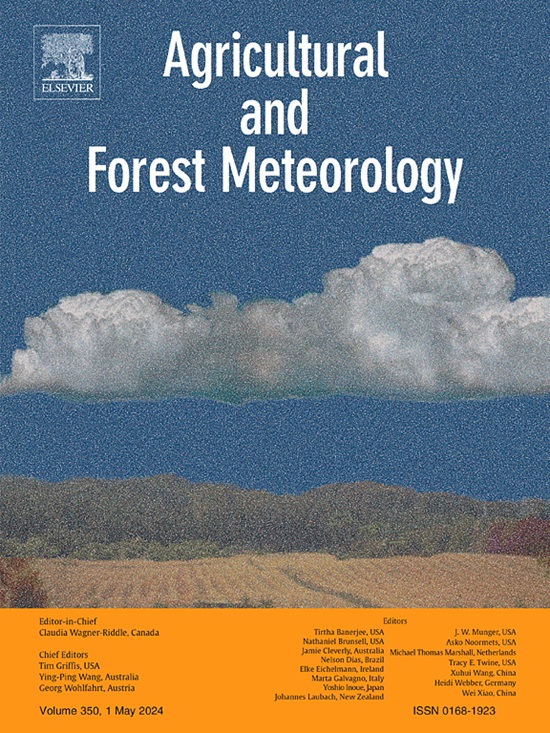森林采伐对土壤呼吸作用及其成分和温度敏感性影响的全球荟萃分析
IF 5.6
1区 农林科学
Q1 AGRONOMY
引用次数: 0
摘要
了解木材采伐对土壤呼吸作用的影响,包括其自养和异养成分及其对温度的敏感性,对于预测森林管理如何影响碳循环至关重要。在此,我们进行了一项荟萃分析,综合了来自全球 143 项研究的 1656 个配对观测数据,在全球范围内评估了这些影响。平均而言,采伐会使土壤呼吸作用增加 6.0%,在针叶林和亚热带地区最为显著。土壤总呼吸作用的反应与其异养部分的变化相比,与其自养部分的变化联系更为紧密。随着采伐强度的增加,采伐对这两种呼吸作用成分的积极影响都有所下降,并且与土壤氮、根系生物量和微生物生物量碳的变化呈正相关。采伐使土壤呼吸的温度敏感性降低了 6.4%,尤其是在针叶林和温带地区。与对照组相比,采伐后最初几年土壤自养呼吸对温度的敏感性有所提高,但在采伐后的后期(约 6 年)则明显降低。此外,收获对土壤呼吸作用、其成分和温度敏感性的影响在不同收获后处理和不同测量季节有很大差异。我们的综合结果为完善生态系统模型提供了基础,从而更好地预测全球范围内采伐森林的土壤碳动态。本文章由计算机程序翻译,如有差异,请以英文原文为准。
A global meta-analysis of forest harvesting effects on soil respiration, its components, and temperature sensitivity
Understanding the effects of timber harvesting on soil respiration, including its autotrophic and heterotrophic components and their temperature sensitivity, is crucial for predicting how forest management affects the carbon cycle. Here, we conducted a meta-analysis to assess these effects on a global scale, synthesizing data from 1656 paired observations from 143 studies worldwide. On average, harvesting increased soil respiration by 6.0 %, most significantly in coniferous forests and subtropical regions. The response of total soil respiration was more closely coupled to changes in its heterotrophic than in its autotrophic component. The positive effects of harvesting on both respiration components decreased with increasing harvest intensity and were positively correlated with changes in soil nitrogen, root biomass, and microbial biomass carbon. Harvesting reduced the temperature sensitivity of soil respiration by 6.4 %, particularly in coniferous forests and temperate regions. The temperature sensitivity of soil autotrophic respiration increased in the first years after harvesting compared to the control but was significantly lower in later stages (c. > 6 years) after harvesting. Furthermore, the effects of harvesting on soil respiration, its components and temperature sensitivity varied greatly between post-harvest treatments and seasons of measurement. The results of our synthesis provide a basis for refining ecosystem models to better predict soil carbon dynamics in harvested forests on a global scale.
求助全文
通过发布文献求助,成功后即可免费获取论文全文。
去求助
来源期刊
CiteScore
10.30
自引率
9.70%
发文量
415
审稿时长
69 days
期刊介绍:
Agricultural and Forest Meteorology is an international journal for the publication of original articles and reviews on the inter-relationship between meteorology, agriculture, forestry, and natural ecosystems. Emphasis is on basic and applied scientific research relevant to practical problems in the field of plant and soil sciences, ecology and biogeochemistry as affected by weather as well as climate variability and change. Theoretical models should be tested against experimental data. Articles must appeal to an international audience. Special issues devoted to single topics are also published.
Typical topics include canopy micrometeorology (e.g. canopy radiation transfer, turbulence near the ground, evapotranspiration, energy balance, fluxes of trace gases), micrometeorological instrumentation (e.g., sensors for trace gases, flux measurement instruments, radiation measurement techniques), aerobiology (e.g. the dispersion of pollen, spores, insects and pesticides), biometeorology (e.g. the effect of weather and climate on plant distribution, crop yield, water-use efficiency, and plant phenology), forest-fire/weather interactions, and feedbacks from vegetation to weather and the climate system.

 求助内容:
求助内容: 应助结果提醒方式:
应助结果提醒方式:


